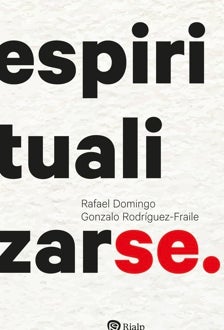‘Being spiritualized’, by Rafael Domingo and Gonzalo Rodríguez-Fraile: path to peace

We find an atypical book, difficult to fit together. It is not a self-help book, at a time of success for that type of literature. It is not a psychology book, although it contains no small amount of psychological perspective.
It is not a philosophy book, although it is not … ignore that perspective; nor ‘management’, although it is not far from referring to certain techniques in that environment. Nor is it a book on the phenomenology of religion, much less theology or spirituality, although it does not ignore prominent religious references. It’s all of the above and more.. A proposed model of understanding spirituality as a path to peace.

-
Authors
Rafael Domingo and Gonzalo Rodríguez-Fraile -
Editorial
Rialp -
Pages
354 -
Price
20 euros
It is difficult to deny that the quality of our life is conditioned by the quality of our thoughts. And that there is an epidemic of negative thoughts. The World Health Organization states that more than 300 million in the world sufferdepression and more than 260 million suffer from anxiety disorders. It is necessary to recover a thought that allows a viable approach to the spiritual world. Something like the works of the theoretical physicist and Anglican theologian John Polkinghorein his book ‘Quantum Physics and Theology: An Unexpected Kinship’.
The thesis of these authors, a law professor and a businessman, an expert in international sureties, is that the search for peace, inner peace, peace with those closest to us, is built through the perfection of the ego and the capacity of the self to transcend. In this process, the soul, a classic concept used to define the non-material, the spiritual, plays a basic role to the extent that it is a catalyst for the physical, the emotional, the mental-sentimental and the spiritual.
As the authors recognize, the path to achieving the peace they propose It is different if it is done from a theistic perspective or from a non-theistic one.to. Here it is done from a theistic perspective, with which the authors have been forced to offer a reflection, sometimes implicit and other times explicit, on what we talk about when we talk about God, what we talk about when we talk about spirituality. This does not prevent there from being common elements, of universal validity, with the non-theistic models of searching for inner peace that are collected here.
Exercise of searching for the common denominator of the main religious traditions of humanity
Here spirituality is asked to verify its postulates and intuitions, that is, to become viable in a plural world. He does not profess any faith, nor does he adhere to any creed or doctrine, I would even say morality. It is built through the exercise of seeking the common denominator of the main religious traditions of humanity, with special emphasis on the Christian and Buddhist legacy, without entering into easy syncretism. A search for that human substrate that exists in every expression of transcendence. A dialogue with those who laid the foundations of Western philosophy, Plato, Aristotle, with some closer to us, such as Romano GuardiniKen Wilber, Edith SteinLeonardo Polo or Byun Chul-Han, and with whom they now work in lThe mind-brain-consciousness relationship.
The final part of the book assumes the pragmatism of this type of literature and offers a list of useful differences to resolve conflicts as well as a series of spiritual maxims that facilitate peace and that are part of the life and experience of the authors.





